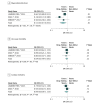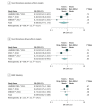Efficacy and Safety of Drug-Eluting Stents Optimized for Biocompatibility vs Bare-Metal Stents With a Single Month of Dual Antiplatelet Therapy: A Meta-analysis
- PMID: 30383145
- PMCID: PMC6583694
- DOI: 10.1001/jamacardio.2018.3551
Efficacy and Safety of Drug-Eluting Stents Optimized for Biocompatibility vs Bare-Metal Stents With a Single Month of Dual Antiplatelet Therapy: A Meta-analysis
Abstract
Importance: A significant number of patients receive bare-metal stents (BMSs) instead of drug-eluting stents (DESs) to shorten the duration of dual antiplatelet therapy (DAPT). Emerging evidence suggests that new-generation DESs, particularly those optimized for biocompatibility, may be more efficacious and safer than BMSs, even with a single month of DAPT after stent implantation.
Objective: To evaluate the efficacy and safety of DESs compared with BMSs for coronary intervention with a single month of DAPT.
Data sources: Human studies found in PubMed, the Cochrane databases through April 2018, and reference lists of selected articles.
Study selection: Randomized clinical trials were included if they enrolled patients undergoing percutaneous coronary intervention and randomly assigned each patient to treatment with either DESs or BMSs. The additional inclusion criterion was use of only 1 month of DAPT poststent implantation.
Data extraction and synthesis: Two reviewers independently extracted the data. Odds ratios (ORs) were calculated using random-effects models.
Main outcomes and measures: The efficacy end points were major adverse cardiac events, myocardial infarction, target vessel revascularization, ischemia-driven target lesion revascularization, cardiac mortality, and all-cause mortality at 1 year. The safety outcomes were stent thrombosis and bleeding complications.
Results: Data from 3 randomized clinical trials involving 3943 patients were included (2457 men [62.3%]; mean [SD] age ranging from 75.7 [9.3] years to 81.4 [4.3] years per trial subgroup). Coronary intervention with DESs reduced the rates for major adverse cardiac events (OR, 0.68 [95% CI, 0.57-0.82]; P < .001), target lesion revascularization (OR, 0.38 [95% CI, 0.22-0.67]; P = .001), target vessel revascularization (OR, 0.50 [95% CI, 0.38-0.65]; P < .001), and myocardial infarction (OR, 0.51 [95% CI, 0.31-0.83]; P = .01) compared with BMSs at 1 year. The incidence of stent thrombosis was also lower with DESs compared with BMSs (1.8% vs 2.8%), but this difference was not statistically significant in the random-effects model. Additionally, the 2 stent types did not differ in the risks of all-cause mortality, cardiac mortality, and bleeding.
Conclusions and relevance: In the limited number of randomized clinical trials comparing DESs with BMSs with shortened DAPT durations in patients who have high bleeding risk or are uncertain candidates for prolonged DAPT, coronary intervention with specific DESs optimized for biocompatibility is not only safe but also efficacious, even with only 1 month of DAPT.
Conflict of interest statement
Figures



Comment in
-
Is There Any Current Role for Bare-Metal Coronary Stents?JAMA Cardiol. 2018 Nov 1;3(11):1059. doi: 10.1001/jamacardio.2018.3660. JAMA Cardiol. 2018. PMID: 30383148 No abstract available.
-
The Myths of the Bare-Metal Stent.JAMA Cardiol. 2018 Nov 1;3(11):1039-1040. doi: 10.1001/jamacardio.2018.3573. JAMA Cardiol. 2018. PMID: 30383161 No abstract available.
-
Quantifying the Treatment Effect of Drug-Eluting Stents Optimized for Biocompatibility vs Bare-Metal Stents With a Single Month of Dual Antiplatelet Therapy.JAMA Cardiol. 2019 May 1;4(5):494. doi: 10.1001/jamacardio.2019.0546. JAMA Cardiol. 2019. PMID: 30916712 No abstract available.
-
Quantifying the Treatment Effect of Drug-Eluting Stents Optimized for Biocompatibility vs Bare-Metal Stents With a Single Month of Dual Antiplatelet Therapy-Reply.JAMA Cardiol. 2019 May 1;4(5):494-495. doi: 10.1001/jamacardio.2019.0556. JAMA Cardiol. 2019. PMID: 30916718 No abstract available.
-
Drug-eluting stents versus bare-metal stents with a single month of dual antiplatelet therapy: a trial sequential analysis.J Thromb Thrombolysis. 2019 Jul;48(1):11-13. doi: 10.1007/s11239-019-01861-6. J Thromb Thrombolysis. 2019. PMID: 30993516 No abstract available.
References
-
- Levine GN, Bates ER, Blankenship JC, et al. . 2015 ACC/AHA/SCAI focused update on primary percutaneous coronary intervention for patients with st-elevation myocardial infarction: an update of the 2011 ACCF/AHA/SCAI guideline for percutaneous coronary intervention and the 2013 ACCF/AHA guideline for the management of ST-elevation myocardial infarction. J Am Coll Cardiol. 2016;67(10):1235-1250. doi:10.1016/j.jacc.2015.10.005 - DOI - PubMed
-
- Levine GN, Bates ER, Blankenship JC, et al. ; American College of Cardiology Foundation; American Heart Association Task Force on Practice Guidelines; Society for Cardiovascular Angiography and Interventions . 2011 ACCF/AHA/SCAI guideline for percutaneous coronary intervention: a report of the American College of Cardiology Foundation/American Heart Association Task Force on practice guidelines and the Society for Cardiovascular Angiography and Interventions. J Am Coll Cardiol. 2011;58(24):e44-e122. doi:10.1016/j.jacc.2011.08.007 - DOI - PubMed
-
- Pfisterer M, Brunner-La Rocca HP, Buser PT, et al. ; BASKET-LATE Investigators . Late clinical events after clopidogrel discontinuation may limit the benefit of drug-eluting stents: an observational study of drug-eluting versus bare-metal stents. J Am Coll Cardiol. 2006;48(12):2584-2591. doi:10.1016/j.jacc.2006.10.026 - DOI - PubMed
Publication types
MeSH terms
Substances
LinkOut - more resources
Full Text Sources
Medical
Miscellaneous

